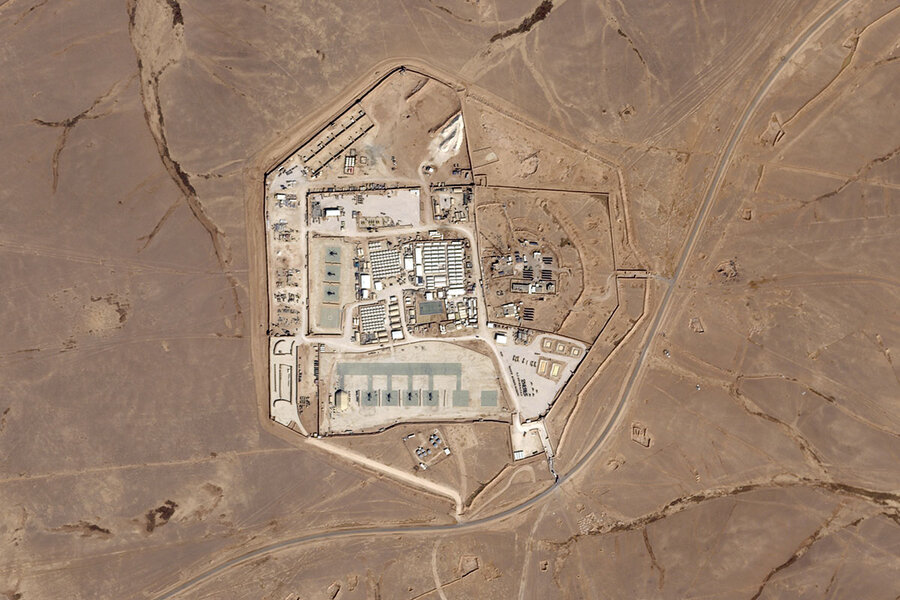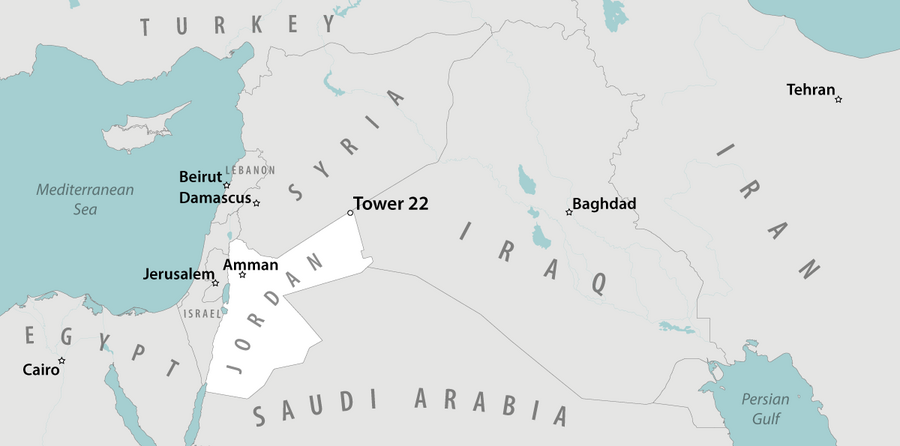Drone attack complicates US effort to contain Middle East conflict
Loading...
As news emerged Sunday that an Iran-backed militant group had killed three U.S. troops and wounded at least 34 other Americans at a remote outpost in Jordan with a drone, President Joe Biden vowed to strike back.
His response will go a long way toward shaping the extent to which the United States is further drawn into the spiraling Middle East clashes that the Biden administration has repeatedly vowed to avoid since Hamas’ devastating Oct. 7 attack on Israel.
Why We Wrote This
The U.S. pledged to retaliate after a lethal attack on American soldiers in Jordan. The Biden administration’s next steps are pivotal in shaping how far the U.S. is drawn into the escalating Middle East conflict.
This latest attack seemed to underscore that the U.S. is already being drawn down the path to wider regional conflict. Analysts note that amid this kind of escalation, the desire to avoid war often runs headlong into the rallying cry for a hard-hitting military response.
Some Republican lawmakers are calling for direct strikes in Iran. Other options include targeting members of Iran’s Islamic Revolutionary Guard Corps’ Qods Force in Iraq, Syria, or Yemen.
“Whether or not it’s a good idea, Biden will have, at minimum, to take steps along those lines,” says Rajan Menon at the Defense Priorities think tank. “Especially because this is an election year and the GOP, and above all [former President Donald] Trump, will flay him for being weak.”
As news emerged that an Iran-backed militant group had killed three U.S. troops and wounded at least 34 other Americans at a remote outpost in Jordan with a drone, President Joe Biden vowed to strike back.
“We lost three brave souls,” he said Sunday. “We shall respond.”
What that means, exactly, will go a long way toward shaping the extent to which the United States is further drawn into the spiraling Middle East clashes that the Biden administration has repeatedly vowed to avoid since Hamas’ devastating Oct. 7 attack on Israel.
Why We Wrote This
The U.S. pledged to retaliate after a lethal attack on American soldiers in Jordan. The Biden administration’s next steps are pivotal in shaping how far the U.S. is drawn into the escalating Middle East conflict.
Just hours earlier, on a Sunday morning news show recorded before the attack, Gen. Charles Q. Brown Jr., chairman of the Joint Chiefs of Staff, emphasized that the U.S. decidedly does not “want to go down a path of greater escalation that drives to a much broader conflict within the region.”
This latest attack, however, seemed to underscore that the U.S. is already being drawn fairly far down this path. Amid this kind of escalation, analysts note, the desire to avoid war often runs headlong into the satisfying rallying cry for a hard-hitting military response.
Precisely who the recipient of this retribution should be, though, is a point of disagreement. What is clear, the Biden administration says, is that the attack was carried out by “radical Iran-backed militant groups operating in Syria and Iraq.”
The umbrella group for many of them, Islamic Resistance in Iraq, has claimed responsibility. Tehran for its part has denied a role in the attack, saying in a statement Monday that Iran had “no connection and nothing to do with” it.
That hasn’t stopped a number of Republican lawmakers from calling for strikes “directly against Iranian targets and their leadership,” as Sen. Roger Wicker of Mississippi, the top Republican on the Armed Services Committee, put it.
Sen. Lindsey Graham demanded Mr. Biden hit “targets inside Iran,” a move he has been calling for since Houthis stepped up attacks on Red Sea shipping lanes in response, they say, to Israel’s post-Oct. 7 war in Gaza.
Merely hitting back at Iran-sponsored groups won’t deter Iran, these lawmakers argue. Yet there are a number of options the Biden administration could choose short of striking Iran directly, analysts point out.
This might include targeting members of Iran’s Islamic Revolutionary Guard Corps’ Qods Force in Iraq, Syria, or Yemen, as the U.S. did in 2020 when it killed the group’s commander by drone strike.
“Whether or not it’s a good idea, Biden will have, at minimum, to take steps along those lines,” argues Rajan Menon, director of the Grand Strategy program at the Defense Priorities think tank. “Especially because this is an election year and the GOP, and above all [former President Donald] Trump, will flay him for being weak.”
Future of U.S. troops in region
Overall, militias with suspected ties to Tehran have conducted some 170 attacks on U.S. bases in the Middle East since Oct. 7. Though the perpetrating groups have framed their efforts as a response to the Israel-Hamas war, they are also an opportunity to accelerate a long-standing campaign to expel U.S. forces from the region.
General Brown said in his pre-attack TV appearance Sunday that he does not think Iran wants war with the U.S. Still, the violent activities of these militant groups, analysts say, are certainly in Iran’s interest.
Among other pluses from Tehran’s perspective, they “align with its goal of raising the risks associated with an open-ended deployment of U.S. troops in Syria and Iraq,” Mr. Menon says.
One of the ongoing questions in the wake of the Sunday attack, in which U.S. officials say the militia’s drone eluded U.S. air defenses by tailing a U.S. drone, is the extent to which these deployments of U.S. forces will continue.
The attack occurred at a U.S. outpost known as Tower 22, where some 350 U.S. troops are deployed and near where the borders of Iraq, Jordan, and Syria come together.
Tower 22 serves as a logistics supply hub, too, for the larger U.S. base at al-Tanf in Syria, a dozen miles away.
While this base was created to support operations against the Islamic State (ISIS) in northern Syria as well as training missions with the Iraqi army, it also serves to disrupt key supply routes used by Iran-backed militias that run from Baghdad to Damascus.
The Trump administration considered closing al-Tanf after the collapse of the ISIS caliphate, but then-national security adviser John Bolton boasted in his 2020 memoir that he helped persuade the president to keep it open.
Israeli Prime Minister Benjamin Netanyahu also reportedly urged against the base closure, given the usefulness of an air corridor for Israeli strikes against Iran-backed militias in Syria.
Risk in either direction
Though tactically handy, these outposts have left U.S. forces vulnerable to attack. Earlier this month, several U.S. military personnel in the Anbar province of western Iraq were wounded in a missile attack by Iran-backed militias.
The dilemma, of course, is that shuttering these bases runs risks, too. Gen. Michael Kurilla, head of U.S. Central Command, warned lawmakers last March, for example, that ISIS will return within one to two years without a U.S. presence in Syria.
Such trade-offs were already confronting the Biden administration before this weekend’s attack. On Saturday, the U.S. and Iraq held the first session of formal talks that could lead to the withdrawal of the 2,500 U.S. forces currently in Iraq.
The Islamic Resistance in Iraq claimed victory for this development as the result of its own violent pressure. The move proves, the group said in a statement, that “Americans only understand the language of force.”
Military analysts say the U.S. might flip that same logic around on Iran and its proxies. Mr. Biden is weighing a counterattack that, he vows, will come “at a time and in a manner of our choosing.”










